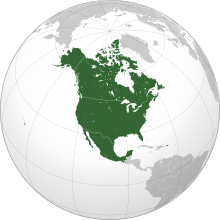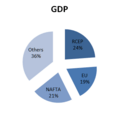North American Free Trade Agreement facts for kids
Quick facts for kids
North American Free Trade Agreement
|
|
|---|---|
| 1994–2020 | |
 |
|
| Languages | |
| Type | Free trade area |
| Member states | Canada United States Mexico |
| History | |
|
• Effective
|
January 1, 1994 |
|
• USMCA in force
|
July 1, 2020 |
| Area | |
|
• Total
|
21,578,137 km2 (8,331,365 sq mi) |
|
• Water (%)
|
7.4 |
| Population | |
|
• 2018 estimate
|
490,000,000 |
|
• Density
|
22.3/km2 (57.8/sq mi) |
| GDP (PPP) | 2018 estimate |
|
• Total
|
$24.8 trillion |
|
• Per capita
|
$50,700 |
The North American Free Trade Agreement (NAFTA Spanish: Tratado de Libre Comercio de América del Norte, TLCAN; French: Accord de libre-échange nord-américain, ALÉNA) was an agreement signed by Canada, Mexico, and the United States that created a trilateral trade bloc in North America. The agreement came into force on January 1, 1994, and superseded the 1988 Canada–United States Free Trade Agreement between the United States and Canada. The NAFTA trade bloc formed one of the largest trade blocs in the world by gross domestic product.
The impetus for a North American free trade zone began with U.S. president Ronald Reagan, who made the idea part of his 1980 presidential campaign. After the signing of the Canada–United States Free Trade Agreement in 1988, the administrations of U.S. president George H. W. Bush, Mexican President Carlos Salinas de Gortari, and Canadian prime minister Brian Mulroney agreed to negotiate what became NAFTA. Each submitted the agreement for ratification in their respective capitals in December 1992, but NAFTA faced significant opposition in both the United States and Canada. All three countries ratified NAFTA in 1993 after the addition of two side agreements, the North American Agreement on Labor Cooperation (NAALC) and the North American Agreement on Environmental Cooperation (NAAEC).
Passage of NAFTA resulted in the elimination or reduction of barriers to trade and investment between the U.S., Canada, and Mexico. The effects of the agreement regarding issues such as employment, the environment, and economic growth have been the subject of political disputes. Most economic analyses indicated that NAFTA was beneficial to the North American economies and the average citizen, but harmed a small minority of workers in industries exposed to trade competition. Economists held that withdrawing from NAFTA or renegotiating NAFTA in a way that reestablished trade barriers would have adversely affected the U.S. economy and cost jobs. However, Mexico would have been much more severely affected by job loss and reduction of economic growth in both the short term and long term.
After U.S. President Donald Trump took office in January 2017, he sought to replace NAFTA with a new agreement, beginning negotiations with Canada and Mexico. In September 2018, the United States, Mexico, and Canada reached an agreement to replace NAFTA with the United States–Mexico–Canada Agreement (USMCA), and all three countries had ratified it by March 2020. NAFTA remained in force until USMCA was implemented. In April 2020, Canada and Mexico notified the U.S. that they were ready to implement the agreement. The USMCA took effect on July 1, 2020, replacing NAFTA. The new law involved only small changes.
Images for kids
-
Back row, left to right: Mexican President Carlos Salinas de Gortari, U.S. President George H. W. Bush, and Canadian Prime Minister Brian Mulroney, at the initialing of the draft North American Free Trade Agreement in October 1992. In front are Mexican Secretary of Commerce and Industrial Development Jaime Serra Puche, United States Trade Representative Carla Hills, and Canadian Minister of International Trade Michael Wilson.
-
Obama, Peña Nieto and Harper at the IX North American Leaders' Summit (informally known as the Three Amigos Summit) in Toluca
-
Former President Enrique Peña Nieto with Prime Minister Justin Trudeau of Canada and then-President Barack Obama of the United States at the 2016 North American Leaders' Summit
-
Chrystia Freeland, Luis Videgaray Caso and Rex Tillerson in Mexico City in 2018
See also
 In Spanish: Tratado de Libre Comercio de América del Norte para niños
In Spanish: Tratado de Libre Comercio de América del Norte para niños







